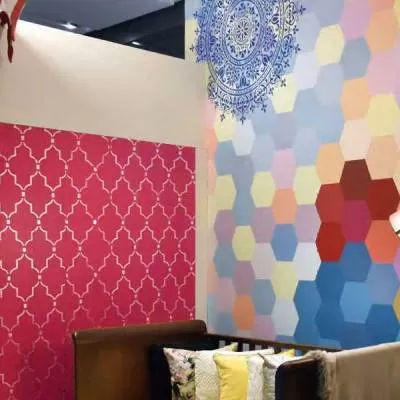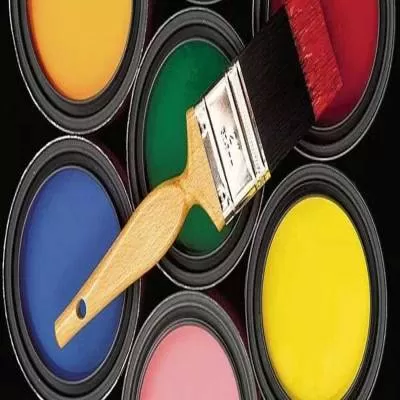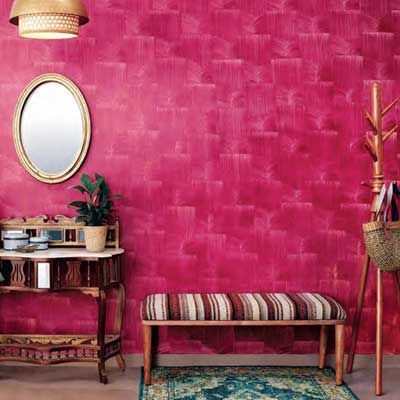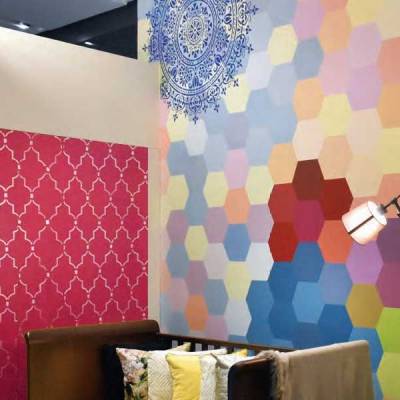- Home
- Building Material
- Paint
- Colour Plus!
Colour Plus!
In the 37th of a series of practical construction tips, Engineer Jagvir Goyal discusses aspects of choosing a colour scheme.
1. Before taking up internal and external finishing work of your building, ensure that all doors and windows have been installed in position; all the electrical conduits, their boxes and fixtures embedded in walls; and walls finished to a smooth surface. Also check that no plaster finishing marks are visible along the conduits embedded. Ensure all plumbing and sanitary pipeline chases have been well filled and finished. After checking these items, take some more precautions. Fix a tape all along the edges of switchboards and window frames. Place jute bag pieces or waste clothes on the floor to save it from paint droppings. While painting external walls, park your vehicles away from the building and cover lawn plants and shrubs with clothing or polythene sheets to save them from paint splatters. Cover all door and window fittings with polythene and seal with tape to protect from damage.
2. Choose the colour scheme of your house carefully. Note that pastel colours in pink and green and blue render a soothing effect while yellow and red look attractive and warm. In India, pastel colours are preferred. Decide the colour scheme according to your personal taste and comfort but keep in mind that once the colours are applied, it won't be possible to change them for the next two or three years. Here is a small but useful colour guide:
• Red: Stimulating and aggressive
• Green: Rejuvenating
• Blue: Elegant, sophisticated and calm
• White or cream: Evergreen, pure and innocent
• Pink: Soft and tender
• Black: Mysterious.
Generally, a colour palette with hundreds of colours is available with paint dealers so you can choose the exact shade you want. The present trend is to provide a dark colour on one wall of a room and project it as a feature wall while a lighter colour is applied on the other three walls.
3. While deciding the colour scheme, check the effect of artificial light on colours. In artificial light, dark colours look brighter while lighter colours look suppressed. Shade cards don't give you the real idea. Visit a friend's house or showroom where you can see the colours on the walls. Before buying the full quantity of paint, test a little on a small area of the wall; allow it to dry and then decide.
4. If the colours of the walls and floor are light, a room will look bigger. So choose light colours for a expansive effect. If the ceiling is low, again choose light colours as these will enhance visibility. If the ceiling is too high, apply dark colour. Shining and reflecting wall surfaces will also make a room look bigger. If you run a strip or band of colour all around the room, it will give it a compact look.
5. Follow a sequence in painting. Always paint the ceiling first. Next, do the walls and, finally, the doors and windows. The most important aspect of painting, your home is to find a good painter as, more than half of your worry is taken care of.
6. Always buy good quality paint from a reputed company such as Asian Paints, Nerolac, ICI, Berger and Jenson & Nicholson, etc. Even if you choose a lower grade-first, second or third quality-buy a reputed brand. This will help you get a well-finished surface. Buy the paint in one lot for uniformity as different manufacturing lots may have a slight difference in appearance.
7. Work out the required quantity of each type of paint to be used by measuring the areas of the walls and the ceiling. Deduct the area of doors, windows, ventilators, openings if any, cupboards, etc, from the wall area. Work out the area of the ceilings. If you can't work this out, as a thumb rule multiply your floor area with five and this is the approximate total area to be painted. Different types of paints have different covering capacities. Wall emulsions such as acrylic, plastic and lustre cover about 80 to 150 sq ft area per litre of paint when applied in two coats. Acrylic and oil-bound distempers cover
60 to 100 sq ft per kg per two coats. Wood enamels cover 80 to 90 sq ft per litre per two coats while transparent finishes cover just 40 sq ft per litre per two coats. Exterior acrylic or textured paint can cover 50 to 75 sq ft area per litre per two coats and cement paints cover about 30 sq ft area per litre per two coats. Coverage capacity differs from company to company.
8. Today, a large variety of wall and woodwork paint is available making it difficult to decide paints to choose for different surfaces. For internal surfaces, the choice is between whitewash, colour wash, dry distemper, oil-bound (oil emulsion) distempers, plastic (acrylic) emulsion paints and premium emulsion paints. For exterior surfaces, the choice is between cement paints such as Snowcem, textured paints, semi-acrylic emulsion paints, 100 per cent acrylic emulsion paints, heritage finish, spectrum finish and cladding. For woodwork, the choice is between synthetic enamel paint, French polish, polyurethane polish and melamine polish.
9. For the most economical finishing work, the combination is cement paint for external walls, dry or oil bound distemper for internal walls, French polish or synthetic enamel of second quality for woodwork and third quality synthetic emulsion for metals. For best quality work where cost is not a consideration, use a combination of dirt-proof and weatherproof 100 per cent acrylic exterior emulsion paint, heritage finish or spectrum finish for external walls, premium emulsion paint for internal walls, melamine or polyurethane finish or best quality synthetic enamel for woodwork and first quality synthetic enamel for metallic surfaces. For medium cost and quality, use textured exterior emulsion paint, semi-acrylic emulsion paint or cladding for external walls, low-range plastic emulsion for internal walls, low-range melamine or polyurethane polish for woodwork and second quality synthetic enamel for metallic surfaces.
10. Avoid painting your house during the monsoon season and when the atmosphere has high humidity. Such conditions don't allow coats to dry quickly. Also moisture gets entrapped between the surface to be painted causing blistering of paint later. Ensure that the surfaces to be painted are fully dry, unless you are using whitewash and Snowcem.
In the 37th of a series of practical construction tips, Engineer Jagvir Goyal discusses aspects of choosing a colour scheme. 1. Before taking up internal and external finishing work of your building, ensure that all doors and windows have been installed in position; all the electrical conduits, their boxes and fixtures embedded in walls; and walls finished to a smooth surface. Also check that no plaster finishing marks are visible along the conduits embedded. Ensure all plumbing and sanitary pipeline chases have been well filled and finished. After checking these items, take some more precautions. Fix a tape all along the edges of switchboards and window frames. Place jute bag pieces or waste clothes on the floor to save it from paint droppings. While painting external walls, park your vehicles away from the building and cover lawn plants and shrubs with clothing or polythene sheets to save them from paint splatters. Cover all door and window fittings with polythene and seal with tape to protect from damage. 2. Choose the colour scheme of your house carefully. Note that pastel colours in pink and green and blue render a soothing effect while yellow and red look attractive and warm. In India, pastel colours are preferred. Decide the colour scheme according to your personal taste and comfort but keep in mind that once the colours are applied, it won't be possible to change them for the next two or three years. Here is a small but useful colour guide: • Red: Stimulating and aggressive• Green: Rejuvenating• Blue: Elegant, sophisticated and calm• White or cream: Evergreen, pure and innocent• Pink: Soft and tender• Black: Mysterious. Generally, a colour palette with hundreds of colours is available with paint dealers so you can choose the exact shade you want. The present trend is to provide a dark colour on one wall of a room and project it as a feature wall while a lighter colour is applied on the other three walls. 3. While deciding the colour scheme, check the effect of artificial light on colours. In artificial light, dark colours look brighter while lighter colours look suppressed. Shade cards don't give you the real idea. Visit a friend's house or showroom where you can see the colours on the walls. Before buying the full quantity of paint, test a little on a small area of the wall; allow it to dry and then decide. 4. If the colours of the walls and floor are light, a room will look bigger. So choose light colours for a expansive effect. If the ceiling is low, again choose light colours as these will enhance visibility. If the ceiling is too high, apply dark colour. Shining and reflecting wall surfaces will also make a room look bigger. If you run a strip or band of colour all around the room, it will give it a compact look. 5. Follow a sequence in painting. Always paint the ceiling first. Next, do the walls and, finally, the doors and windows. The most important aspect of painting, your home is to find a good painter as, more than half of your worry is taken care of. 6. Always buy good quality paint from a reputed company such as Asian Paints, Nerolac, ICI, Berger and Jenson & Nicholson, etc. Even if you choose a lower grade-first, second or third quality-buy a reputed brand. This will help you get a well-finished surface. Buy the paint in one lot for uniformity as different manufacturing lots may have a slight difference in appearance. 7. Work out the required quantity of each type of paint to be used by measuring the areas of the walls and the ceiling. Deduct the area of doors, windows, ventilators, openings if any, cupboards, etc, from the wall area. Work out the area of the ceilings. If you can't work this out, as a thumb rule multiply your floor area with five and this is the approximate total area to be painted. Different types of paints have different covering capacities. Wall emulsions such as acrylic, plastic and lustre cover about 80 to 150 sq ft area per litre of paint when applied in two coats. Acrylic and oil-bound distempers cover 60 to 100 sq ft per kg per two coats. Wood enamels cover 80 to 90 sq ft per litre per two coats while transparent finishes cover just 40 sq ft per litre per two coats. Exterior acrylic or textured paint can cover 50 to 75 sq ft area per litre per two coats and cement paints cover about 30 sq ft area per litre per two coats. Coverage capacity differs from company to company. 8. Today, a large variety of wall and woodwork paint is available making it difficult to decide paints to choose for different surfaces. For internal surfaces, the choice is between whitewash, colour wash, dry distemper, oil-bound (oil emulsion) distempers, plastic (acrylic) emulsion paints and premium emulsion paints. For exterior surfaces, the choice is between cement paints such as Snowcem, textured paints, semi-acrylic emulsion paints, 100 per cent acrylic emulsion paints, heritage finish, spectrum finish and cladding. For woodwork, the choice is between synthetic enamel paint, French polish, polyurethane polish and melamine polish. 9. For the most economical finishing work, the combination is cement paint for external walls, dry or oil bound distemper for internal walls, French polish or synthetic enamel of second quality for woodwork and third quality synthetic emulsion for metals. For best quality work where cost is not a consideration, use a combination of dirt-proof and weatherproof 100 per cent acrylic exterior emulsion paint, heritage finish or spectrum finish for external walls, premium emulsion paint for internal walls, melamine or polyurethane finish or best quality synthetic enamel for woodwork and first quality synthetic enamel for metallic surfaces. For medium cost and quality, use textured exterior emulsion paint, semi-acrylic emulsion paint or cladding for external walls, low-range plastic emulsion for internal walls, low-range melamine or polyurethane polish for woodwork and second quality synthetic enamel for metallic surfaces. 10. Avoid painting your house during the monsoon season and when the atmosphere has high humidity. Such conditions don't allow coats to dry quickly. Also moisture gets entrapped between the surface to be painted causing blistering of paint later. Ensure that the surfaces to be painted are fully dry, unless you are using whitewash and Snowcem.
























